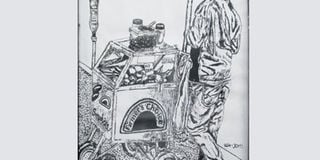Hawkers have pride of place in Wanjohi’s art

Anthony Wanjohi's “Hawkers” series can be found at his studio at Kuona in Kilimani.
What you need to know:
- Anthony Wanjohi is an Eastlander from Bahati, which gives him the edge on the subject that he is currently focused on illustrating in his art — hawking.
- Street sellers who charmed Wanjohi into capturing their lives in photos, prints and paintings can hardly be seen in Nairobi’s city centre anymore. They have been cast out of town.
- Initially, he was painting, but he now spends practically all his time creating prints of Nairobi’s jua kali sales folk.
- And although the City County wants to treat them like undesirables, to Wanjohi they are some of the hardest working people in town.
Anthony Wanjohi has never had an identity crisis. He knows he was born and bred a ‘Nairobi boy’. He is an Eastlander from Bahati, which gives him the edge on the subject that he is currently focused on illustrating in his art — hawking.
“A lot of the people that I paint are from my neighbourhood,” says Wanjohi who has a keen interest in creating art works around the hawkers of Nairobi ever since he created paintings to submit to the GoDown’s annual art competition of 2017.
“For that show, I painted traffic jams, matatus and hawkers,” says the Kuona-based artist. “I didn’t win (Manjano 2017), but it got me interested in doing more (artistically) with the hawkers,” he says.
HAWKERS
However, the ad hoc street sellers who charmed Wanjohi into capturing their lives in photos, prints and paintings can hardly be seen in Nairobi’s city centre anymore. They have been cast out of town.
Ironically, the street vendors have been replaced by glue-sniffers who can be found on nearly every CBD street corner at night.
Fortunately for Wanjohi, he had already built up a substantial archive of images of hawkers and working people trying to eke a living selling whatever they can on the streets. He has taken photographs of jua kali salesmen of sweets, sausages, boiled eggs and even screw drivers.
He has also photographed — using his humble Nokia smartphone — women selling everything from githeri, chapati and steamed maize to spinach, garlic and French beans, to bottled water and chewing gum.
“The lady who sells sweets on the street always seems to be more successful than the guys,” observes Wanjohi, speculating that it has probably got a bit to do with her smile.
These are the images that the artist translates into paintings or prints. Increasingly, he has been working with prints while using a variety of colours.
INSPIRATION
“I’ll work with the same image but print with various colours,” says the artist who describes himself as ‘self-taught’ but admits he has found inspiration online, in newspapers and magazines.
“When I was at Pumwani Primary, I used to trace comics like Andy Capp and Tin Tin,” says Wanjohi. “I also tried to draw like Gado and Maddo do in the local newspapers”.
In secondary school, he got involved in designing sets for school theatre productions.
“In my last two years in secondary school, I created backdrops for plays, which I really enjoyed,” he says.
Soon after school, he heard about Kuona Trust when it was still based at The GoDown Art Centre.
“From 2005, I used to hang out there and admire the artworks,” he recalls. Due to financial constraints, he was not in a position to pay rent to join either Kuona or GoDown. Instead, he worked at jobs that put bread on the table.
“I pumped gas for a few years. I also did some construction work,” he says. However, Wanjohi felt the one thing he could do well was art. When he was not working during the day, he was either drawing or keeping track of the local art scene through Facebook.
PAINTING AND PRINTS
By 2016, he finally figured he had better take art more seriously and applied for a studio at Kuona Trust, which was recently re-named Kuona Artists Alliance.
“I got space there in January 2017, and I’ve been there ever since.”
Initially, he was painting, but then he was shown how to make prints by David Thuku, one of the founders of the Brush tu Art Studio, who is currently based at Kuona.
He now spends practically all his time creating prints of Nairobi’s jua kali sales folk. And although the City County wants to treat them like undesirables, to Wanjohi they are some of the hardest working people in town.
His “Hawkers” series can be found at his studio at Kuona in Kilimani.




